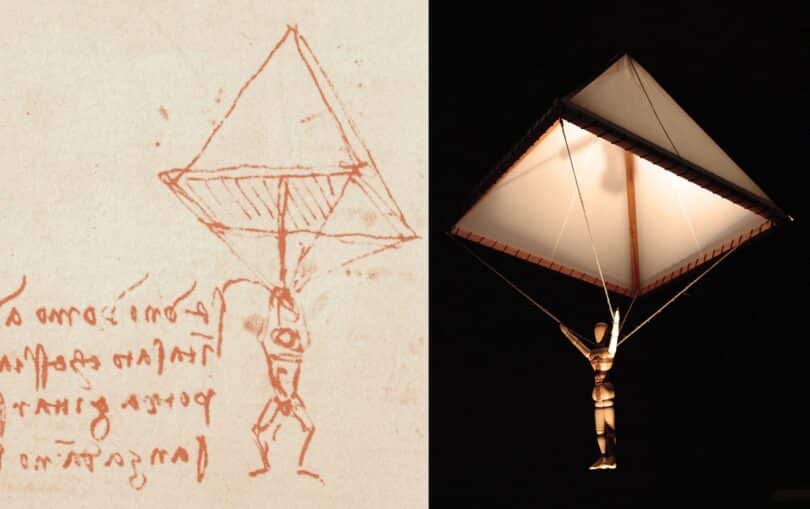Leonardo da Vinci, the quintessential Renaissance man, is revered for his extraordinary skills in art, science, and engineering. Among his many innovative creations is the parachute, a device he designed to enable pilots to safely descend from their flying machines.
In the 1480s, Leonardo became deeply fascinated with the concept of human flight. His numerous sketches and notes reveal a mind driven by an insatiable curiosity to understand the mechanics of flight and to design machines capable of achieving it.

Parachute by Leonardo da Vinci, 1485. Photo Credit: Flight Museum.
The Ornithopter and Aerial Screw
Leonardo’s two most famous flying machine designs are the ornithopter, a glider-like contraption with flapping wings, and the aerial screw, a helicopter-like device with a large, spiraling rotor. Although neither machine was built during his lifetime, they demonstrated Leonardo’s profound understanding of aerodynamics and his ability to envision innovative solutions.

Leonardo da Vinci – Design of a Helicopter
The Invention of the Parachute
Recognizing the potential dangers associated with flying, Leonardo also considered the need for pilots to abandon their aircraft in emergency situations. He realized that a device to slow their descent and ensure a safe landing would be essential.
Leonardo’s parachute design, sketched in his famous Codex Atlanticus, consisted of a pyramid-shaped structure made of linen, supported by a wooden frame. The design relied on the principle of air resistance to slow the descent, allowing the pilot to land gently.

Model of Parachute of Leonardo da Vinci. Black & white photograph from the Science Museum Photo Studio Archive. Under the Creative Commons Attribution-NonCommercial-ShareAlike 4.0 Licence
Validation of Leonardo’s Parachute
Though never constructed during Leonardo’s time, his parachute design was put to the test in the year 2000 by Adrian Nicholas, a modern skydiver. The experiment proved successful, with the parachute functioning as intended and providing a smooth descent.
Leonardo da Vinci’s invention of the parachute showcases his remarkable foresight and innovative spirit. His design laid the foundation for modern parachutes, which have saved countless lives in aviation and continue to provide thrill-seekers with the exhilarating experience of skydiving.
Feature Image Credit: Nevin Dilmen on Wikimedia Commons








Good, but no much information.
Me da mucha información gracias